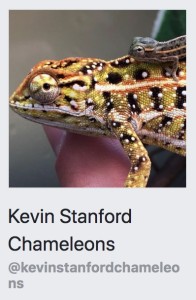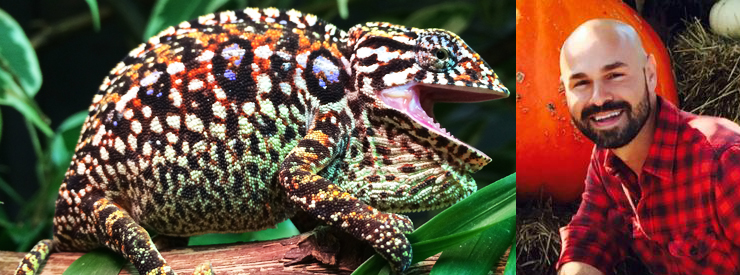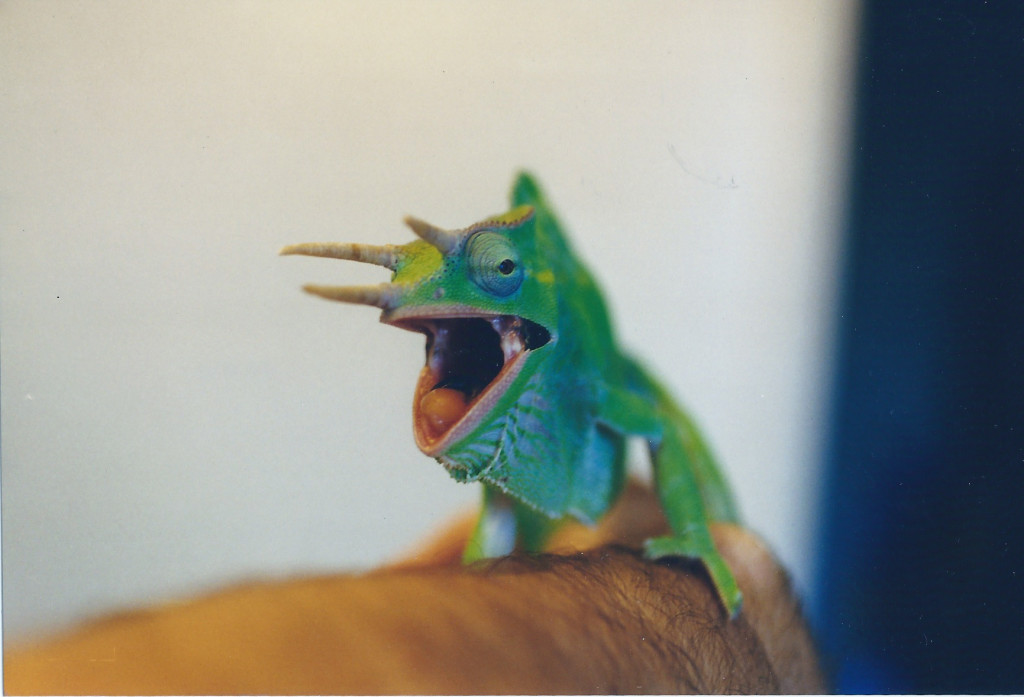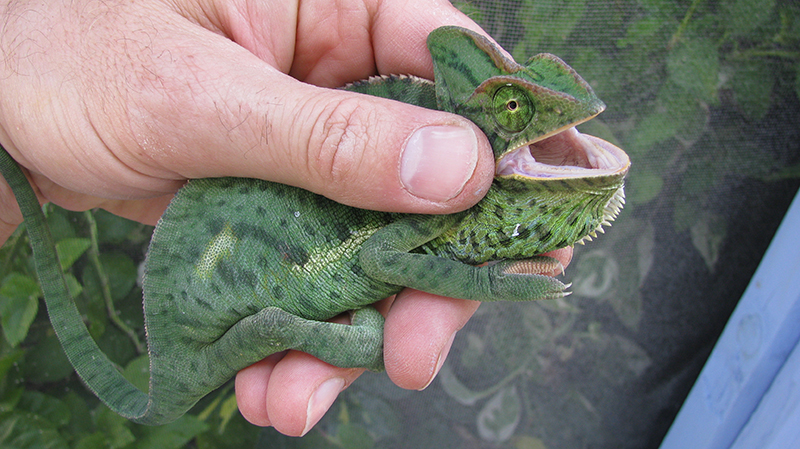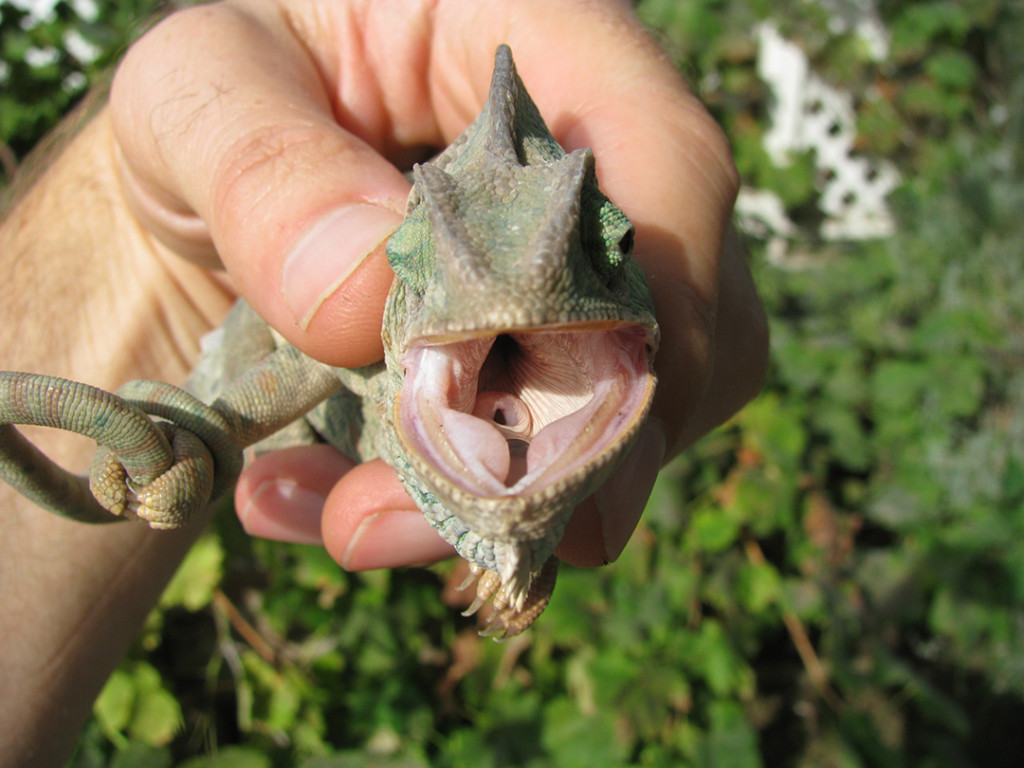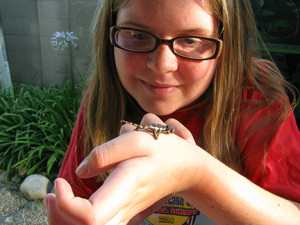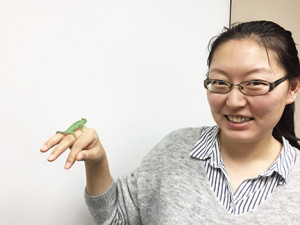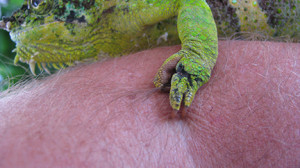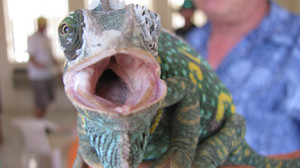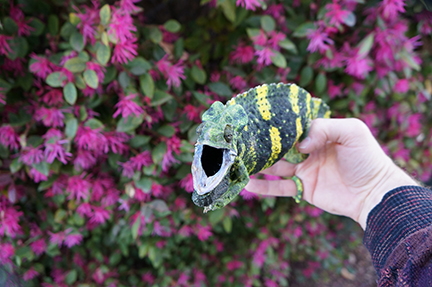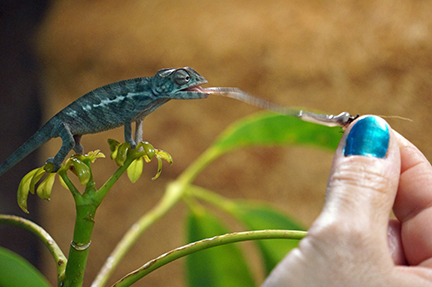One of the first questions people ask about chameleons is how to tame them. Generally speaking, chameleons are not designed to be interacted with. But being in a human world there is great value in their being comfortable with us and our hands. Today we talk a bit about how to do a slow progression to your chameleon being comfortable with you.
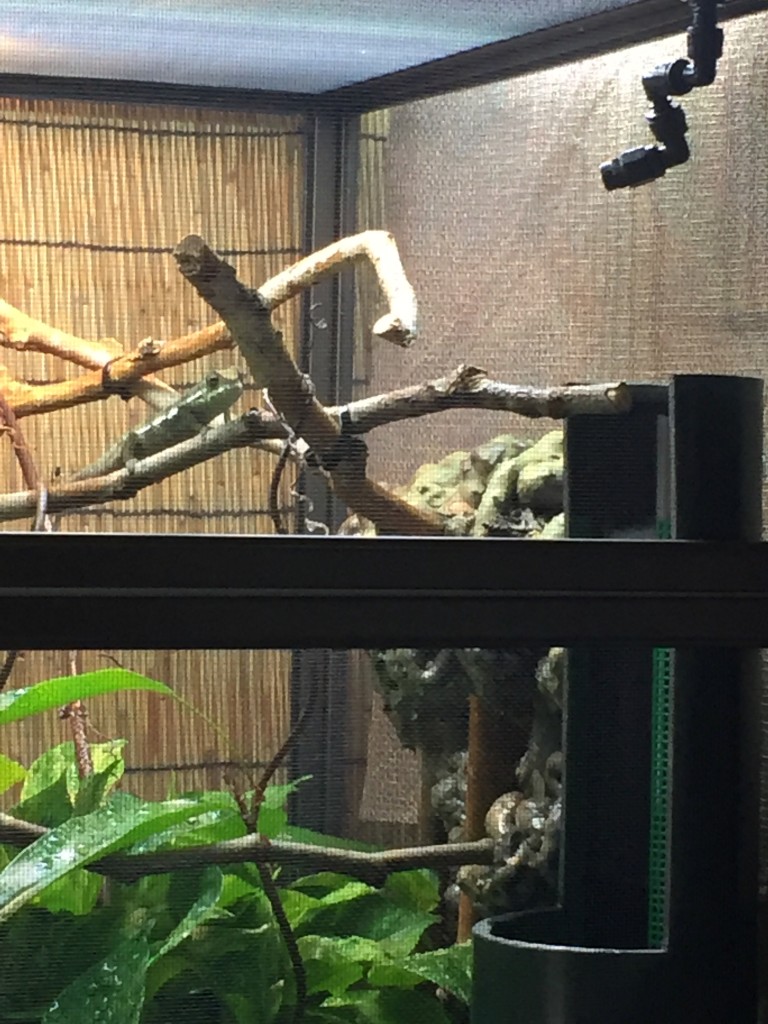
This is my little Ambanja Panther Chameleon. We are to the taming point where when he sees me come home from lunch he goes to his food bowl! He does not like my hand in the cage, but already he is starting to equate me with food.
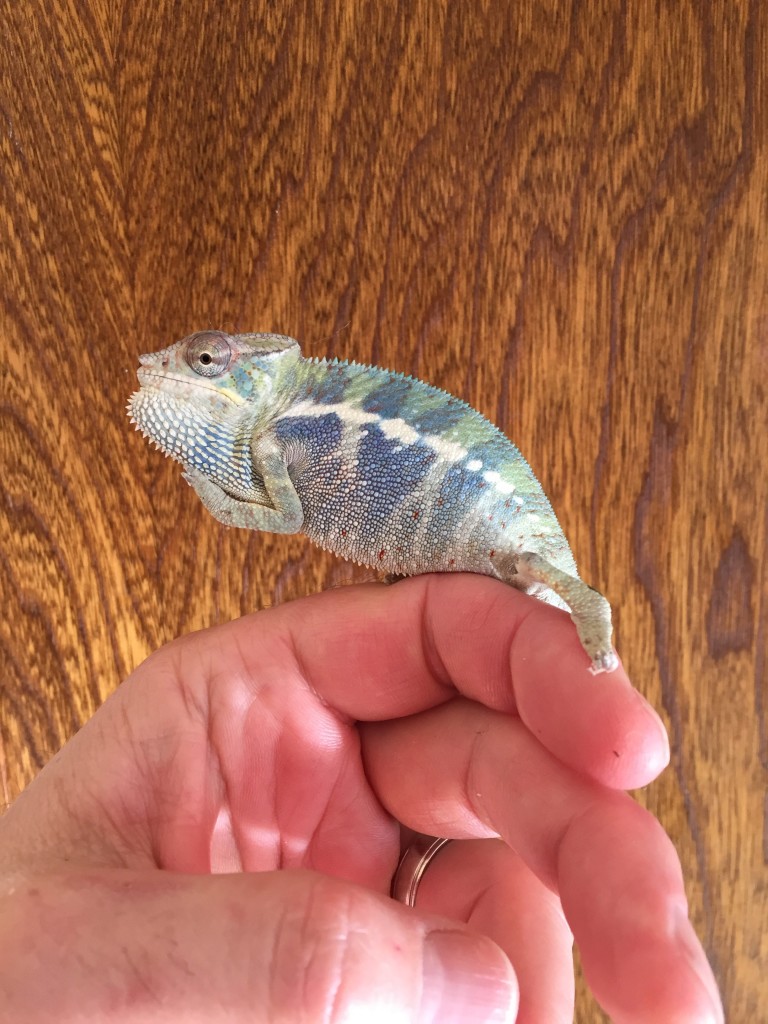
Here’s my little guy showing his blues coming in. He is also showing that we have a ways to go in our taming process!
Today we are talking about taming your chameleon. This is a controversial topic as one side of the argument ask why you would want to get a chameleon and impose your mammalian herd culture on this reptilian being. The other side insists that chameleons have this inner capacity to love and bond to their humans.
My position on this is pragmatic. Our value of love, long term bonding, and the elevating of people who selflessly give of themselves to benefit others is a result of our dependence on our herd for survival. Humans need each other and our brains have certain feel-good chemicals that reward us when we establish bonds. Serotonin and oxytocin are secreted to reinforce our group cohesion. These chemicals build communities which take care of each other and bond couples during that long child rearing stage. In fact, we humans grow depressed without others. So much of our songs, movies, and culture revolves around relationships. So we have a very hard time understanding the foreign concept of loose social structures.
Putting aside the topic of how chameleons interact with each other, one thing that is very clear is that chameleons will be very happy having nothing to do with you. But we have trouble having nothing to do with them. We want to interact. We can go on with a spirited debate as to the emotional capabilities of chameleons or how much interaction is appropriate in our chameleon hobby. But the common component in all of our philosophies is that our chameleons will have to have some level of comfort being in a human world. There are some species that are so high strung that they do well only if they never see a human. These are not found in the pet trade and chameleon enthusiasts must work hard to get a hold of them. So they know what they are doing and are excited about the challenge of keeping an animal where the measure of success is that the animal never sees the keeper. For the other 99% of chameleon keepers we want to at least see them and would love to have them not run in fear of us. And, unless you are an expert keeper working on keeping Trioceros owenii, your chameleon will need to be able to deal with exposure to you and the other humans walking around the house on a daily basis. So regardless of your handling philosophies, it is useful to implement at least basic taming strategies.
(And as a side note, it will be interesting to see if there is a difference between wild caught and captive hatched T. owenii. It would be nice to find that out one day. And to those unaware of what is possibly the most elusive of the six three horned species, Trioceros owenii is reported to be one of the most high strung and human hating chameleons.)
Expectations
To start off with, we need to set expectations. This podcast will lead you through lessening the fear your chameleon has for you. The ideal chameleon student of this course will graduate feeling comfortable stepping onto your hand and being carried away from his branch. We will not be touching on helping him to step on your hand without a compelling reason or enticing him to want to spend quality time with you. This episode will cover taming down to allow standard chameleon maintenance and a little bit of recreational handling with as little stress as possible.
Strategies
We will approach our taming challenge from two simultaneous directions. When we are first introduced to our chameleon we are a big thing that will potentially eat them. We will work to first communicate that we are not a danger and second, have us associated with food. That is pretty much the basis of all relationships! If you want to make friends, share your peanut butter and jelly sandwich. We all know how this works!
We are going to go over a basic progression that starts with your chameleon distrustful of you and ends with him walking on your arm of his own choice.
Before we start here are some basics
- Move Slowly
To start off, move slowly and smoothly around your chameleon. No quick jerky moves. Be predictable and calming. You can do sessions where you come into the room and move about without looking him in the eye. That gives him the security of feeling like he is hidden and not having to worry about what you are thinking. Then glance at him slowly and relaxed. Have this demeanor when you clean his cage. Time and patience is your friend. Get your chameleon used to normal every day activity done at a low energy level. Walking in the room, walking out of the room. Cleaning the cage and feeding. It is a good thing that he equates you opening the cage with getting food. Chameleons are pretty smart and will figure out you mean good things. If you are an expressive talker take your phone calls outside the chameleon room. Your pet will not know what to do with the wild and quick hand motions that accompany effectively explaining the latest drama in your life.
- Careful with what you wear
A fascinating thing about chameleons is that they can identify us and they know their keeper. Just realize that they select certain markers to identify us by and if these change we may appear to be a stranger. Hats, glasses, or any other change may make your tame chameleon treat you like he doesn’t know you. Also, certain colors or shapes, such as a baseball cap, may make them feel threatened or get them riled up. You’ll have to be sensitive to how your chameleon sees and identifies you. And each chameleon has their own way. If your chameleon one day reacts negatively to you in an uncharacteristic way, consider what has changed about your appearance.
- Chameleons watch where you are looking. You looking away is a tool if you need to diffuse a situation. Getting them comfortable with you looking at them is a necessary step in our program.
Note that each chameleon will proceed through these steps at their own pace. Some lucky keepers will get a chameleon that crawls out of the importation bag onto your arm, eats a roach from your other hand and then looks at you as if they are trying to figure out what kind of strange tree you are. Some will panic at the opening of their cage, drop to the floor, and act like you are a deranged vampire here to steal their soul. Most will have some combination of fear and annoyance. You can’t control what they will be beyond trying to make the best selection from a writhing mass of babies at the reptile show so just accept what you get and we will go from there.
Our goal is going to be to use food to get them comfortable eating around you and walking on you. We will take small steps to get there and have four major milestones.
Our first milestone is to get them comfortable enough around you that they will eat while you are around. This shows a comfort with your presence
Milestone 2 is them eating from your hand while they are in their cage and on their branch
Milestone 3 is them being baited to crawl onto your hand
And, finally, milestone 4 is eating from your hand while perched on your other hand.
These milestones were selected for a purpose. They are a progression of deeper and deeper comfort. Eating is a milestone not only because we humans just can’t get enough of the process, but because eating in your presence is a huge sign of trust on the chameleons part. Eating is the one time that those constantly roaming eyes stop their job watching for danger and switch to fully focus on eating. It is a vulnerable time for your chameleon. In chameleon language, eating in front of you is a sign of trust – especially if the food is in the other direction from you and they can’t see you in their peripheral vision.
So our first milestone has them trusting us when the cage door is closed. This should be pretty simple. Most chameleons get here without too much trouble. The second milestone is a pretty big one. You are in their cage and can, at any time, grab them. For them to eat from your hand means they are not concerned with this possibility. The third step is pretty big as well. This is where they step onto your hand. This is significant because their branch and the ability to swivel behind it is an ingrained defense mechanism that they can employ at a moment’s notice when a predatory drops out of the sky. By stepping onto your hand they lose this option. So they are giving up a bit of security. By time we get to the fourth milestone we have a chameleon that is giving up security in a number of ways to get a treat from their moving tree.
So let’s get started.
Our first milestone was to get your chameleon to eat while you are in the room. This is a challenge for chameleons that are getting used to cages and humans. You will probably spend a little bit of time at this level if you have a wild caught chameleon. If you have a captive bred, your baby grew up being fed by humans and this milestone will be an easy gold star. Your key to passing this milestone is just time. The more time you spend around your chameleon without being a threat and occasionally feeding your chameleon the more comfortable he’ll get with you. Here is where you can use the fact that chameleons watch your eyes and know when you are looking at them. Spend much of the time deliberately not looking at them. Then when it is time to feed them, calmly make eye contact and bring the food to their cage. Doing this on a regular basis gets them familiar with you. You may find that they will wait until you are not looking before they eat. But this is all about baby steps. First they eat while you are in the room, then they eventually think it is stupid to wait because you are harmless! Usually when training or taming we think of restricting food to entice them to do what we want. This is hardly an exact science so do what you please in this regard. When I am doing this stage in taming I actually give food regularly. My goal at this stage is to have them familiar with me and to connect me with food appearing. I want normal life to happen and them to settle in. If they seem particularly stubborn after time you can always skip a feeding or two in order to properly motivate them.
Before we go on I would like to directly address the withholding of food for taming purposes. A healthy chameleon can easily go a week without food and not suffer. So you have that time period to play with. But I caution you to make sure your chameleon is healthy before you start playing these games. A wild caught chameleon must be fully acclimated and over the rigorous importation process. This doesn’t mean you can’t go through some of the taming process with a wild caught. It just means you be careful when using hunger as a motivator. The absolute prerequisite to anything you do with your chameleon is get the health up first.
Milestone 2 is your chameleon eating from your hand while perched on their branch. You can work up to this by putting feeders in the feeder bowl and leaving the door open while they eat. Chameleons see their door as protection. So eating while the door is closed is much different than when it is open. Once they are comfortable eating while you have left the door open you can reduce your feeding frequency to give them some twinges of hunger. Then just give them one feeder per feeding by putting your hand in the cage with the feeder and offering it to them well within tongue range. You’ll probably get your chameleon feeling very nervous about this situation. After a bit of time where it is obvious nothing will happen just release the feeder into the feeder dish or so it can crawl up the side of the cage. If you reduce the amount you feed and start every feeding like this eventually your chameleon should be less and less patient for you to release the food item and will tag it out of your fingers.
Big hint time. You make it easier for your chameleon to feel comfortable doing this if you place the feeder between you and the chameleon so the chameleon does not have to take their eyes off you to focus on the feeder.
Second big hint. Look at the feeder, not your chameleon. I know we want to watch our chameleon eat. But you watching the cricket or whatever feeder it is means you are not watching him and he knows it. If you stare at the feeder then your chameleon will feel safer taking his eyes off of you and concentrating on the feeder too. In some cases, I have actually closed my eyes to make a chameleon feel better at eating from my fingers.
This stage may take a while. Once again, be patient. Remember, there is no race and no one is timing you.
And, there is actually a third big hint…You can do these exercises with crickets or any food item, but it is more effective if the training sessions with you use a special treat feeder. Special treats may be hornworms, silkworms, wax worms, walking sticks, green grasshoppers, or anything else that is not a main food staple and your chameleon has shown they get excited about. Each chameleon has their special passion. Find it and you have a valuable tool in your relationship building!
Our next milestone requires some movement. We want to train the chameleon to come after the food and eventually have your chameleon willingly use your arm to get closer to its food. I suggest hand feeding until it becomes routine for your chameleon. When your chameleon is so trained to eat from your fingers than he will zap anything you hold you know you are there. I had my panthers so tamed that it really didn’t matter what I had in my fingers. They would rush over and eat it. These were wild caught, by the way. I had a big cricket that I grabbed wrong and I stunned it so it wasn’t moving. Not even a hesitation from my panther. They were so enthusiastic that I had to be careful what I had in my hand when I opened the cage. At this point I could easily have them slither through the branches towards anywhere my hand was. After all this time they knew whatever was in my fingers was worth some effort. Yeah, that was fun. I miss those guys! Once you can get them to move towards the food you can place the food so stepping onto your hand or arm is the only way to the food. Honestly, this step will be the hardest of all these steps. If you can achieve arm walking you are in the top tier of chameleon taming! The way to do this is to place your arm near and under your chameleon and hold the feeder so your chameleon has to step on your hand just one step to get at the feeder. Use what you know about being behind the feeder or starring at the feeder. It is interesting, but you looking at the feeder actually gives a sense of urgency in some chameleons. I have noticed that some chameleons have a competitive streak in them and forget all about what big, scary me will do to them when I shift my eyes to the feeder. All of a sudden they scramble to get the treat before I do. Yes, we and chameleons are very different creatures, but there certainly are some basic similarities! I am sure at this point you know what comes next. You start with one step onto your hand and then you let them retreat on their own so they do not feel like stepping on your hand is a loss of options for them. You are giving them free agency to step on or off your hand at their convenience. Once they get to the point where they step all the way onto your hand you can move you hand closer to the feeder to communicate that if they step onto your hand it may be to take them to a treat. If you can get the to the point where they will step onto your hand merely on the hope that you will be taking them to some unseen treat you will have completed this university with honors and need to get into graduate studies!
In reality, most chameleons will not be able to make it to the end of this taming regimen. And that is okay. I know you may have had the goal of doing a “Me and my Chameleon” reality show where you and your buddy travel the world getting into misadventures, but I will be very happy if, by following these steps, you end up with a chameleon that is comfortable with you being in the room, doing basic maintenance, and maybe even getting excited when you walk in because of the treats that they will soon get. And I am actually serious about that. Especially panther chameleons, they are smart cookies. I once had a large scale breeding facility and the best part of the day was the panther feeding. Each male panther had a six foot tall, heavily planted cage so there was this row of just cages and jungle. You didn’t always see the inhabitant. But when the feeding bin showed up at the end of the aisle you saw all these brightly colored males appear out of the bushes and place themselves as close to the door as possible anticipating their food. Honestly, they were breeders so I really was not doing any taming program on them. They just did this on their own! So you do have some pretty good intelligence to work with in some species. We just have to motivate them.
The basic goal of this podcast episode, and all of these exercises, is to get the chameleon to the point where it does not fear you. You may only get as far as that. You may live your life with a chameleon that wants nothing to do with you and is annoyed that you exist. Although this end may be disappointing, it is a reasonable result for what we are working with.
Final thoughts on handling
In conclusion, your chameleon will go at his own pace and have a certain limit. I had a female Jackson’s Chameleon that would be content to sit on my hand and take walks around the garden. She knew we were going to pick off all sorts of butterflies and garden pests. And I had a Crested Chameleon (Trioceros cristatus) that would not pass the first stage in chameleon taming kindergarten in her lifetime.
As for me, I am happy with any level of tameness. My fascination with chameleons is in what they are. I am very happy with observing their interactions in their cages. I am more focused on creating environments that allow them to fully realize themselves as a chameleon than trying to force them into my human world. I say let Tarzan be Tarzan in the jungle. Dressing him up in clothes and putting him in the middle of London is…well…in my opinion, that just isn’t what Tarzan is. I have chameleons in my life to connect me with nature and expand my awareness of this world. I can only do that by keeping chameleons as chameleon as possible. But I do want them to be okay with being in a human world so I do the basic taming on my chameleons. I have a gorgeous new pair of Furcifer pardalis, Ambilobe Panther Chameleons, that I am keeping as pets and these are an exception. I am slowly working on taming them. I am slightly put out that they have taken a liking to my wife first, but I’ll just have to suck it up and carry on! How far will these go? They are multi-generational captive bred from Kammerflage Kreations so I will not find a more genetically adapted for captivity chameleon out there. But still, it took 100 million years to develop a dislike for things large enough to eat them. There is only so much that can be done in 20! But we will see and I’ll share my progress here!
How far will yours go? If you are starting with a panther or veiled you have a pretty good chance of getting somewhere. Just go slow. If your chameleon hobby teaches you anything it will be patience!
As long as you learn your chameleon’s body language and you go at your chameleon’s pace you should be fine. And, of course, accept whatever limitations your chameleon places on the relationship.
Thank you for joining me here. Until next week, spend at least once per day marveling at the incredible mini-tree dragon you share your life with.
